#vanderbilt avenue
Explore tagged Tumblr posts
Photo










Accordion Headquarters, One Vanderbilt Avenue, New York, NY 10017,
BHDM Design
#art#design#interiors#workplace#office#headquarters#accordion#vanderbilt avenue#new york#luxurylifestyle#BHDM design#laid#oak wood#designtex#clubhouse#kitchen#firm#consulting
62 notes
·
View notes
Text
guys i was so caught up in the euphoria of seeing jeremy jordan perform that bama’s loss to vandy hasn’t really hit me
#also walked to grand central station that day across vanderbilt avenue#which was ironic#but seriously how do we beat georgia (the NUMBER ONE TEAM)#then lose to vanderbilt the next week (who we haven’t lost to in FORTY YEARS)#it’s embarrassing honestly#11am kickoff this week. save me#mer talks
3 notes
·
View notes
Text

The mid-afternoon sunlight reflecting off One Vanderbilt's glass façade created a powerful glare that lit up Park Avenue

0 notes
Text

1927 c. William K. Vanderbilt and his wife Rosamund Lancaster Warburton on Fifth Avenue. From New York City-Vintage History, FB.
68 notes
·
View notes
Text

Nixon met Winters at the station. The first thing he noticed was that his friend was in full uniform. “Thought you were eager to be a civilian?” he asked. “I’m working on it,” Winters replied. “Just give me time.” Nixon flagged a cab that took them to the posh, twenty-story Yale Club at Vanderbilt Avenue and Forty-Fourth Street, and began showing his former commander off to his alumni friends. The next stop was the hospital where Nixon’s mother was a patient. “She was very, very nice and pleasant,” he recalled. “I can remember her very definitely trying to say nice things, the right things, like ‘I’ve heard a lot of good stories about you’ and so forth.” When the sun went down the two wartime comrades went out on the town, or rather, Nixon took Winters out on the town. Not surprisingly, Nixon dragged his friend to nightclubs and bars, where the young man from Lancaster would sit, fidgeting in his chair, while Nixon downed drink after drink. “I was not used to that kind of thing at all, it was all new to me and I was very uncomfortable,” Winters recalled. “But there I sat all prim and proper.” Ironically, although it was Nixon who was getting drunk, it was Winters who nearly got into a barroom brawl. While the two were sitting at a table at one of Nixon’s nightspots, a man who had had almost as much to drink as Nixon staggered up to the pair. He spotted Winters’ uniform, the brass buttons and golden oak leaves gleaming in the light. “Well, well,” he said in an alcohol-laced voice. “Lookee here. We got a soldier. And an officer to boot. What are you doin’ here, General?” Winters ignored him. “Hey, General, are you deaf?” he prodded. “Blow,” Nixon told the man. “I ain’t talking to you, fella, I’m talkin’ to this nice, neat-looking soldier boy.” Winters saw anger flash in Nixon’s eyes, and his own slow fuse was starting to burn. “Look at that fruit salad,” the man said, noting Winters’ array of ribbons. “You must be a hero, General. Are you a hero?” Winters did not respond. “Are you too good to talk to me? You’re not a hero. You’re a sucker.” Winters had just about enough of this drunken fool when a waiter, knowing trouble when he saw it, hustled over and snatched the man by his upper arm. “Why don’t you find a nice corner somewhere else to drink?” he said and shouldered the man to another part of the room. “I could barely hold myself in,” Winters said later. “I was getting ready to kill that son of a bitch.”
~ Larry Alexander
#band of brothers#dick winters#lewis nixon#aww nix so proudly showing dick off all around the town#Biggest Brother: The Life Of Major Dick Winters The Man Who Led The Band of Brothers
73 notes
·
View notes
Text

Summit One Vanderbilt, New York: Above floor 73, the top of One Vanderbilt contains an observation deck called Summit One Vanderbilt. Summit One Vanderbilt spans 71,938 square feet and contains some restaurants. There is a bar on the top floor where you can enjoy a cocktail and watch New York from the best advantage point... One Vanderbilt is a 73-story supertall skyscraper at the corner of 42nd Street and Vanderbilt Avenue in the Midtown Manhattan neighborhood of New York City. Wikipedia
92 notes
·
View notes
Text

New York circa 1900. "Grand Central Station, E. 42nd Street and Vanderbilt Avenue."
#vintage#turn of the century#New York City#streetcars#horse drawn carriage#1900s#street scene#trolley#NYC#horse and buggy#streetcar
60 notes
·
View notes
Text

Gertrude Vanderbilt Whitney
Artist: Robert Henri (American, 1865–1929)
Date: 1916
Medium: Oil on canvas
Collection: Whitney Museum of American Art, New York City, NY, United States
Description
Gertrude Vanderbilt Whitney, founder of the Whitney Museum, commissioned this portrait in 1916 from Robert Henri, leader of the urban realist painters who had shocked the New York art world barely a decade earlier with their images of ordinary people and commonplace city life. By 1916, Mrs. Whitney, a professional sculptor, had founded the Whitney Studio in Greenwich Village, a lively center for the support and exhibition of new American art. When Henri’s portrait was finished, Mrs. Whitney’s husband, Harry Payne Whitney, refused to allow her to hang it in their opulent Fifth Avenue town house. He didn’t want his friends to see a picture of his wife, as he put it, "in pants." Mrs. Whitney’s attire and self-possessed demeanor were highly unusual for a well-bred woman of her day. In this painting, Henri transformed the traditional genre of a recumbent female—usually a nude courtesan or the goddess Venus—into a portrait of the quintessential "modern" woman. The portrait hung in Whitney’s West 8th Street studio, which in 1931 became the first home of the Whitney Museum.
#portrait#female#horizontal#gertrude vanderbilt whitney#realism style#sculptor#artist#american culture#robert henri#american painter#oil on canvas#seated#sofa#plants#fashion#20th century painting#elegant
27 notes
·
View notes
Text
Vanderbilt Triple Palace: the daughters' homes
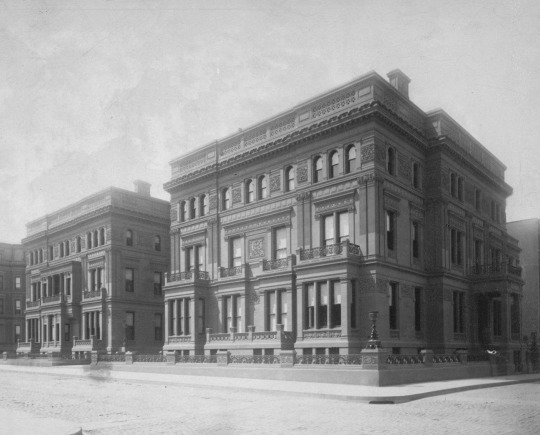



Completed in 1882, William H. Vanderbilt's Triple Palace, located at 640 Fifth Avenue in New York, consisted of two buildings: a single-family unit to the south and a two-family unit to the north. William lived in the south unit, while the north unit, which is the focus of this post, was a double mansion, inhabited by two of his daughters, Emily T. Vanderbilt Sloane and Margaret L. Vanderbilt Shepard and their respective families.
The mansion was designed in Doric and Corinthian styles with a facade covered in brownstone, but as I didn't have all the elements in that color, I used gray limestone. For the interior decoration, I was inspired by the portraits of each of the owners. In the left part of the house, which belonged to Emily, the rococo style predominates in yellow, light blue and white. The right side, Margaret's, is more Victorian in style, with lots of wood paneling and red brocade on the walls.
As it's a double house, I think it's perfect for playing with The Sims 4 For Rent expansion :)

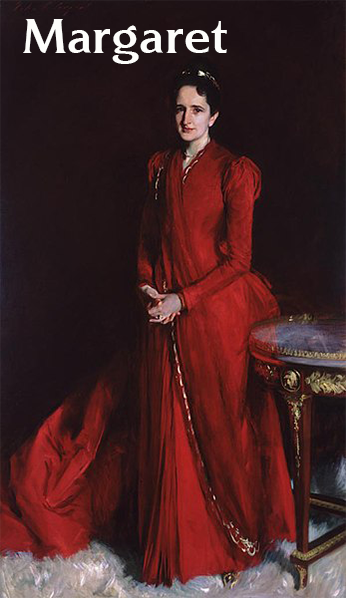














59 notes
·
View notes
Text
Merchandise Pop-Up Store Tour "Teyvat Goods" is about to begin!

Hello, Travelers!
Our Merchandise Pop-Up Store Tour "Teyvat Goods" is about to begin!
The first stop will be in New York. Come and say hi to other Travelers!
Event Duration: April 28 – May 2, 10:00 – 20:00
Location: 607 Vanderbilt Avenue, Brooklyn, NY 11238



#genshin impact#genshin impact updates#official#genshin impact news#damn wish i lived in an actual location#rural gang
371 notes
·
View notes
Text


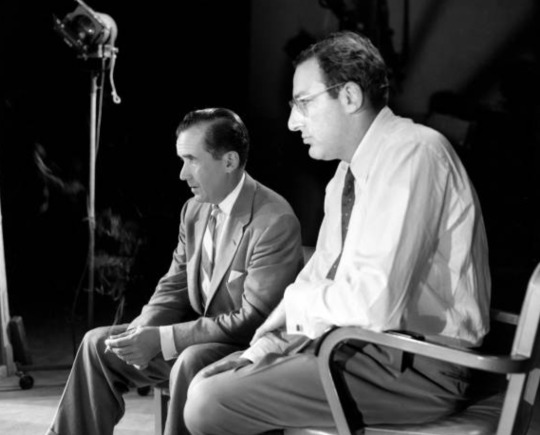
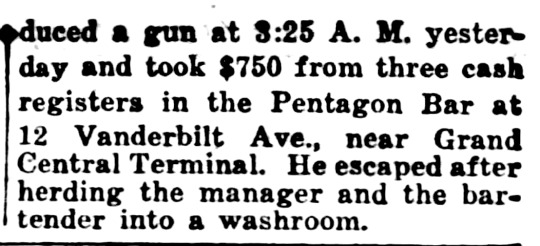





Edward R. Murrow and Fred Friendly frequently got drunk at the Pentagon Bar located at 12 Vanderbilt Avenue in Manhattan.
13 notes
·
View notes
Text


( jacob elordi . cis man . he/him ) - the new york city resident , holden newman , was seen sporting bruno cucinelli on park avenue today . the twenty six year old is a journalist in the city & has been here for eight years . since being here , they have been told to be cynical , but also compassionate , who really knows ! according to nycslam , he has been covering up certain unlawful activities that his mother's family has engaged in . anyways , guess we'll find out for ourselves !
full biography • playlist • pinterest
I. STATS
full name: holden theodore newman
gender & pronouns: cis-male, he/him
age & birthday: 26, april 13th, 1997
occupation: journalist
time in nyc: 8 years
II. BACKGROUND
born in new canaan, ct. his mother was a broke socialite (not really broke, she still was richer than the average person but ya know nowhere as rich as before) and a doctor.
back to his mom, she belongs to a very known and old family in the us (think the vanderbilts bc yes that’s the family i based this from) but holden doesn’t really talk about them and really doesn’t know that side of his family well.
his dad, au contraire, had humble beginnings and worked hard to pay his way through college and med school. they met in 1994, at the hospital he worked at and well they fell in love and holden was born 3 years later.
was the perfect mix of his parents’ personalities. he share his mom’s love for art and his father’s thirst for knowledge. overall, he was very curious and sensible kid.
not the most committed student. he was always living in his own world, dreaming of the worlds he read in books or watched in films. however, he was naturally smart and so he did good at school.
death tw: his father passed away when he was eleven years old and from that moment on it was as if something within him died as well.
holden and his mom drifted apart after that since none of them knew how to share their grief with the other.
his mom began spending a looooot of money. so much that made holden anxious and he used to go to bed thinking about the family’s finances which, ya know, no thirteen year old should be concerned about that.
matured very fast, pretty much missed his teenage years and couldn’t wait to go to college and idk being thirty, flirty and thriving.
attended university in columbia where he majored in literature.
holden always loved writing and researching. he started in high school and later decided to study literature and journalism in college. after graduating, he tried to get a job with the new york times but didn't succeed.
struggling to become an on-air reporter, holden asked a friend for help, and they made a fake press pass. he sneaked into important events, recorded news reports, and sent them to networks in the hope of getting a break. this led to an internship at cnn. in the last three years, he moved up quickly and is now a reporter and writes a column for the new york times.
III. PERSONALITY
if you are into personality tests and all that stuff here’s the tea: intj, type 6 (enneagram), type a, phlematic (temperament), lawful good, aries, ravenclaw.
cynical idealist, skeptical by nature, covertly hopeless romantic, walking paradox, inadvertently tactless.
has a very quixotic personality and even if he tries to conceal it, he still daydreams a lot.
he is still very sensible not even life can take that away from him so please no one cries in front him or he will leave so he doesn’t cry and start a vicious cycle of crying. no one wants that.
a worrier. he worries about everyyything and he just can’t help it which makes him a bit uptight.
very organized, i guess some could say, he’s a bit neurotic.
competitive so don’t invite him to trivia night
wouldn’t say he’s shy but he is indeed very reserved and rarely talks about himself.
extremely critical and most of his criticism is directed at himself but he can be a bit judgmental but never with malice.
dry, dark and sarcastic sense of humor that sometimes is not welcomed. especially because he’s very tactless so he doesn’t have that comedic timing so it comes across as questionable. the type that makes him go like “it’s a joke btw” and people just awkwardly laugh and walk away.
actually fun to be around when he feels comfortable or stress free aka once a year.
IV. PLOTS IDEAS
they’re closing the bar and they want us to leave: holden doesn’t even know how he became ‘friends’ with this person as they don’t have many interests in common. somehow, when this person gets too drunk to drive calls holden to help them and since he can’t really say no, he always complies. with nico
i’ll tell you the truth, but never goodbye: he struggles to keep close relationships as he is the kind of friend who will leave you on read for weeks or decline plans every weekend. however this person has always been there, even when it seems he’s trying to push them away. maybe they haven’t said it out loud but actions speak louder than words and these two are best friends. with grey
do you have the time to listen to me whine?: i guess his mom gave him that name because somehow she knew he would like to complain about many things. so this person could be the one who is there to tolerate all his rambling and at the end give him some advice. holden considers them good friends as he usually is not this chatty unless he feels comfortable around someone.
we locked eyes from a distance, so close but i missed it: i wouldn’t say holden has a crush on this person but he’s definitely intrigued by them. they run into each other often but either holden avoids the conversation or he keeps it short even when he’d rather do the opposite.
they’ve been sayin’ you’re sophisticated: he has tried to keep this as a secret, to the extent of lying about where he grew up. maybe this person met holden back when he lived in the us or their family knew holden’s mom. idk the details but hopefully you get the idea. with yesenia
school yard conversations taken to heart: he grew up mostly in connecticut but after his father passed away he and his mother moved back for a couple of years to new york. maybe they went to the same school and idk connection from the past pretty much.
do you know what it means when you think on a screen?: pretty much they matched on a dating app and they’ve been talking for some time but they haven’t really met in person yet. it’s not really romantic but they have a connection (could become romantic tho depends on chemistry) with yildiz
the devil’s in the details, but you got a friend in me: while he’s not a social butterfly, in the past year he has formed a small group of friends and he feels comfortable around them to let them see more of his personality.
i wanted to believe in all the words that i was speaking as we moved together in the dark: maybe it all started as a hook up and it evolved to a friends with benefits sort of situation. maybe the other person started to get feelings but to holden is was purely physical. he tried to force feelings for this person but it simply wasn’t there and now they ended up in bad terms.
i know your heart belongs to someone you’ve yet to meet: maybe they dated a few years ago (we can work out the logistics) and he was very into this person and thought it would become a serious thing but then he moved to london and the distance made him realize that his feelings were not as strong.
right where you left me: the opposite of the previous idea. pretty much the roles reversed and it’s them who left holden with really no explanation.
everybody wonders what it would be like to love you: holden had a massive crush on this person. sometimes they talked but he never told them anything. he might still have some feelings for them but it’s nothing but the leftovers of an unresolved crush. with eloise
you wouldn’t be the first renegade to need somebody: this could be a friendship that could turn into something more kinda connection. it could be angsty idk. but pretty much this is someone that wants to get to know holden or at least become friends but he keeps putting these walls between them even if he really enjoys their company.
friends don’t get chills with every accidental touch: they’ve been very good friends for some time and they are comfortable with each other, so comfortable that it seems there’s something else there. with moira
#richfm:intro#( holden newman ) / * general .#wanted to make a graphic but photoshop makes my laptop slow#death tw
9 notes
·
View notes
Text
Since 2018, conservative state legislatures across the country have proposed and passed laws targeting young transgender people’s freedom to to play on sports teams and use bathrooms that correspond with their gender, and to obtain gender-affirming health care. Advocates for trans rights argue that the increased interest in the subject has served to galvanize the energies of those who had fought an ultimately losing battle against gay marriage—and have observed how the anti-trans movement has used tactics that have proved successful in limiting abortion. As with much legislation of this type, amid the nationalized, culture-war politics, the effects are felt most acutely by the most vulnerable families and individuals.
In a startling piece of reporting in this week’s issue, Emily Witt follows a mother named Kristen Chapman who moves her family from Tennessee to Virginia, in order for her daughter Willow to continue receiving gender-affirming care. “I genuinely feel we are being run out of town on a rail,” Chapman says. “I am not being dramatic. It is not my imagination.” With nuance and compassionate precision, Witt captures the urgency of the family’s relocation, and the sense, as laws seem to change underfoot, of pursuit. As she writes, “Chapman had chosen Virginia for their new life, she said, because it was still in the South, but there would be ‘multiple avenues of escape.’ ”
On the last morning of July, Kristen Chapman was getting ready to leave Nashville. Chapman, who is in her early fifties and wears her silver hair short, sat on a camp chair next to a fire pit outside the rental duplex where her family had lived for twelve years. She was smoking an American Spirit and swatting at the mosquitoes that kept emerging from the dense green brush behind her. Her husband, Paul, who was wearing a T-shirt with the Guinness logo, carried boxes out to the front lawn. Their daughters, Saoirse and Willow, who were seventeen and fifteen, were inside, still asleep. Chapman looked down at the family’s beagle mix, Obi-Wan Kenobi, who was drinking rainwater out of a plastic bucket. “We got him when we moved in here for the kids,” she said. “He’s never lived anywhere else.”
Paul was planning to stay in town; Chapman was heading to Richmond, Virginia, with Saoirse and Willow. Chapman and Paul’s marriage was ending, but the decision to split their family apart had happened abruptly. Willow is trans, and had been on puberty blockers since 2021. In March, Tennessee’s governor, Bill Lee, had signed a bill that banned gender-transition treatment for minors across the state.
On paper, the law, which went into effect in early July, would allow trans teens like Willow to continue their medical care until March of 2024. But Chapman wasn’t sure they could count on that. Willow was determined to begin taking estrogen when she turned sixteen, in December of 2023, which would allow her to grow into adulthood with feminine characteristics. If she couldn’t continue taking puberty blockers until then, she would begin to go through male puberty, which could mean more surgeries and other procedures later in life.
At first, the family had hoped that the courts would declare the new law unconstitutional. Federal courts had already done so in at least four other states in 2023, finding that such bans violated the First Amendment and the equal-protection and due-process clauses of the Fourteenth Amendment. But that spring the Pediatric Transgender Clinic at Vanderbilt University Medical Center, where Willow had been receiving care, informed its patients that it was ceasing operations. Seeing this as a bad sign, Chapman set up a GoFundMe page in early May and began planning their departure.
Inside, the apartment was filled with abandoned objects—an old Wi-Fi router, trash bags of unwanted clothes. A Homer Simpson doll in a hula skirt lay forgotten on a windowsill. Chapman, an artist who supplements her income with social work, had recently quit her job as a caseworker. She would need their landlord as a reference to get an apartment, especially because she had bad credit, but the family still owed him back rent. She checked Venmo, waiting on a loan from a friend.
At six-thirty that morning, Chapman had gone out to her white Dodge S.U.V. and found her younger daughter asleep in the back seat. Willow had gone over to a friend’s house and stayed out late. When she got home, she realized that she had locked herself out. The Dodge’s window had been stuck open for months, so she got in. “Any other human being would have handled this totally differently,” Chapman said, shaking her head.
Willow had gone back to sleep in her room, which she once shared with her brother. (He was a sophomore in college and had already moved out.) The colorful scarves and lights that used to decorate the space had been taken down. When she woke up, she began sifting through what was left. “I feel like I’m ready to say goodbye to it,” she said, looking around. There were drawings scrawled on the wall, a desk spattered in paint. “Most of the stuff in here I’ve trashed.”
“It’s like getting a new haircut,” Chapman said. “A fresh palette.”
Chapman had chosen Virginia for their new life, she said, because it was still in the South, but there would be “multiple avenues of escape.” Paul worked nights for a large grocery-store chain; Richmond was among the northernmost cities where it had branches, and Chapman thought that at some point he might be able to transfer there. Earlier in the summer, she and Willow had driven to Richmond to see the city, and Chapman had lined up a marketing job. It didn’t pay well, but she knew she wouldn’t get a lease without a job. Willow, who had received her last puberty-blocker shot at the Vanderbilt clinic in late May, was supposed to receive her next one in late August. They didn’t have a lot of time.
Despite having taken puberty blockers for two years, Willow looks her age. She is tall and long-limbed and meticulous about her appearance. That morning, she had on Y2K-revival clothes: wide-legged jeans worn low on the hips with a belt, a patterned tank top, and furry pink Juicy Couture boots. Her blond hair was glossy and straight, her bangs held back with a barrette. She is committed to living her adolescence as a girl regardless of what medical treatment she is allowed to receive. At times she has used silicone prosthetic breasts; attaching them is an onerous process involving spray-on adhesive.
From a very young age, Willow wore dresses and gravitated toward friendships with girls. Her parents thought that she would likely grow up to be a gay man. As Chapman put it, “We knew she was in the fam.” When a homophobic shooter killed forty-nine people at Pulse, the gay night club in Orlando, in 2016, Willow, who was eight at the time, accompanied her mother to a vigil in Nashville. Willow wrote a long message on a banner in solidarity with the survivors. Chapman took a photo of her there. “It was like she was transfixed,” Chapman remembered. In the sixth grade, Willow went to an all-girl sleepover. A parent overheard the kids discussing gender and sexuality, and told Chapman. Willow says that it was around then that she began to think about her identity. “Pretty much as soon as I knew about, like, conceptualized gender, I knew I wanted to be a girl,” she said. She had been an A student, but her grades started going down. Looking back, Willow struggled to articulate what had happened. “It just got complicated, like with all my stuff physically, it just felt like a mess,” she said.
She came out to her friends first; then one day, in the spring of 2020, while she was upstairs on her laptop and Chapman was downstairs working, Willow sent her mother a three-word e-mail that said, “I am trans.” Willow told me, “I realized I have to do this sometime if I want to advocate for myself and get what I need to get.” She left it to her mother to inform the rest of the family. Chapman was accepting; Paul was more skeptical. “That’s him, you know—a man of science,” Chapman said. “It wasn’t overly positive or negative.”
Willow had already decided on her new name before coming out, and began using it with friends. She was again reluctant to tell her family. “I was, like, I’ll keep that secret,” she said—she had been named at birth for a brother of her father’s who had died, and knew the name was important to him. Her mother found out when another mom referred to Willow by her chosen name. Chapman started using it right away; it took Paul another year.
To figure out their next steps, Chapman took Willow, who was then twelve, to her regular pediatrician at Vanderbilt University Medical Center. She was referred to the center’s Pediatric Transgender Clinic. The clinic, which opened in 2018, was part of a broader expansion of gender-affirming care at flagship medical schools in the South that occurred around that time. (Clinics also opened at Duke University, the University of Mississippi, and Emory University, among other schools.) These places “attracted the kind of people who build very trusting relationships with patients and are able to establish not just the clinical competencies but also an inclusive environment,” Jasmine Beach-Ferrara, the executive director of the Campaign for Southern Equality, an advocacy group for L.G.B.T.Q. rights, told me. “All those things are nothing you can take for granted when seeking medical care in the South.” (Federal funding for health care is often funnelled through state governments, some of which have a history of withholding money from providers that offer abortion and other politicized health services.)
Care for patients who are experiencing gender dysphoria is highly individualized: some trans kids opt for a purely social transition, changing their names or pronouns; others, like Willow, seek a medical transition, which can be started at the onset of puberty. In Willow’s case, a diagnosis of gender dysphoria had to be verified before pharmaceutical treatment could begin. A course of psychotherapy was accompanied by a physical assessment at Vanderbilt, which included ultrasounds, X-rays, and blood tests. The clinic was following a protocol supported by the Endocrine Society and the World Professional Association for Transgender Health, whereby patients take puberty blockers—which have been used to treat children experiencing early-onset puberty since the nineteen-eighties—to delay the onset of secondary sex characteristics until they are ready to begin taking estrogen or testosterone.
“I’d always explain it to the families as a pause on puberty, allowing the youth to take a deep breath,” Kimberly Herrmann, a pediatrician and internist at Whitman-Walker Health, a provider in the Washington, D.C., area that offers gender-affirming care to patients aged thirteen and over, told me. (Some patients choose to go through their natal puberty.) “All of the data suggests that it is the correct thing to do for a patient with a clear diagnosis,” Izzy Lowell, a doctor who started a telehealth practice for gender-affirming care called QueerMed, said, of taking puberty blockers. “If they are going to develop the body of a grown man, it becomes difficult to undo those changes.”
Paul was worried about the blockers’ long-term effects on Willow’s health. (Studies have shown that they can affect bone density when used long term, and the protocol for hormone therapy advises doctors to discuss potential risks to fertility and options for fertility preservation.) Chapman thought the risks to Willow’s well-being would be worse if she developed male secondary sex characteristics. In one testimony against the Tennessee ban, an adult trans woman described her adolescence, in which she attempted to present as male, as “a disastrous and torturous experience.”
“Paul and I talked about it and came to the belief that we wanted her on them as quickly as possible for safety reasons,” Chapman said. “I hate that that’s true, but we know that’s the world that we live in, and that she is going to be a safer person for the rest of her life if she does not look male.” (A recent analysis of crime statistics from 2017 and 2018 found that transgender people are more than four times as likely as cisgender people to be the victims of a violent crime.)
The evaluation and diagnosis took almost a year. For Willow, the talk therapy was the most taxing part. Willow was insured through the state’s Medicaid program, TennCare, which meant that there were only a limited number of therapists she could see, none of whom were trans, or even queer. She went through three in a year. “We were in the lowest tier of care,” Chapman said, adding that at least one therapist dropped their health insurance. Willow told her mother that she wished she could just be left alone to be a “sad trans girl.”
At the age of thirteen, she was finally able to start puberty blockers. “You have an end goal,” Willow said of the experience. “And all the in-between doesn’t matter.”
In September, 2022, the conservative commentator and anti-trans activist Matt Walsh, who moved to Nashville in 2020 (along with his employer, the conservative news company the Daily Wire), posted a thread on Twitter. “Vanderbilt drugs, chemically castrates, and performs double mastectomies on minors,” it began. “But it gets worse.” Walsh—who is the author of books including “Church of Cowards: A Wake-Up Call to Complacent Christians” and “What Is a Woman?,” a polemic arguing that gender roles are biologically determined—worked in conservative talk radio before being hired by the Daily Wire as a writer, in 2017. Last year, the left-wing watchdog group Media Matters for America mapped Walsh’s origins as an aspiring radio shock jock in the early twenty-tens who once said, “We probably lost our republic after Reconstruction.” In 2022, he was one of several right-wing social-media pundits who began broadcasting misinformation about hospitals that provided gender-transition treatment for minors, which were then overwhelmed with phone and e-mail threats and online harassment. One study found that more than fifteen hospitals modified or took down Web sites about pediatric gender care after being named in these campaigns.
Walsh included in his thread about Vanderbilt a video clip of Shayne Taylor, the medical director of its Transgender Clinic, speaking of top and bottom surgeries as a potential “money-maker” for the hospital. Walsh did not specify that Taylor was mostly speaking about adults. (Vanderbilt never performed genital surgery on underage patients and did an average of five top surgeries a year on minors, with a minimum age of sixteen.) More than sixty Republican state legislators signed a letter to Vanderbilt describing the clinic’s practices “as nothing less than abuse.” In a statement calling for an investigation, Governor Lee, who was up for reëlection, said that “we should not allow permanent, life-altering decisions that hurt children.” Within days, Vanderbilt announced that it would put a pause on surgeries for minors. Jonathan Skrmetti, Tennessee’s Republican attorney general, began an inquiry into whether Vanderbilt had manipulated billing codes to avoid limitations on insurance coverage.
In October, Walsh and other anti-trans advocates held a “Rally to End Child Mutilation” in Nashville’s War Memorial Plaza. The speakers included the Tennessee senator Marsha Blackburn, the former Democratic Presidential candidate Tulsi Gabbard, and Chloe Cole, a nineteen-year-old self-described “former trans kid.” After identifying as male from the age of twelve, receiving testosterone, and getting top surgery, Cole de-transitioned to female at sixteen and is now one of the country’s foremost youth advocates of bans on gender-transition treatment for minors. “I was allowed to make an adult decision as a traumatized fifteen-year-old,” she said at the rally.
For the past four years, the number of anti-trans bills proposed throughout the United States has dramatically risen. The A.C.L.U. has counted some four hundred and ninety-six proposals in state legislatures in 2023, eighty-four of which have been signed into law. The first state ban on gender-transition treatment for minors was passed in Arkansas in 2021. It was permanently blocked by a federal judge this year, but more than twenty states have passed similar laws since then. As lawsuits filed by the A.C.L.U., Lambda Legal, and other organizations make their way through the courts, trans people are left to navigate a shifting legal landscape that activists say has affected clinical and pharmaceutical access. Lowell told me that she consults with six lawyers (including one she keeps on retainer) to best advise patients, who must frequently drive across state borders to receive care. “It’s literally a daily task to figure out what’s legal where,” she said.
In Tennessee, the Human Rights Campaign has counted the passage of at least nineteen anti-L.G.B.T.Q. laws since 2015, among the most in the nation. Some of these laws have been found unconstitutional, such as a ban on drag shows in public spaces and a law that would have required any business to post a warning if it let transgender people use their preferred rest room. But many others have gone into effect, such as laws that censor school curricula and ban transgender youth from playing on the sports teams that align with their identity.
Proposals to ban gender-transition treatment for minors were the first bills introduced in the opening legislative sessions of the Tennessee House and Senate in November, 2022. “It was Matt Walsh who lit a fire under the ultraconservative wing of the Republican Party this year,” Chris Sanders, the director of a Nashville-based L.G.B.T.Q. advocacy group called Tennessee Equality Project, told me. “It was lightning speed the way it all unfolded.” At hearings throughout the winter, parents of trans kids, trans adults, trans youth, and a Memphis pediatrician who provides gender-affirming care testified against the ban. Those who spoke in support of it included Walsh, Cole (who is from California), and a right-wing Tennessee physician named Omar Hamada, who compared such treatment to letting a minor who wanted to become a pirate get a limb and one eye removed.
L.G.B.T.Q. activists who attended described feeling disregarded by the Republican majority. Molly Quinn, the executive director of OUTMemphis, a nonprofit that helps trans youth navigate their health care, likened the experience to “being the only queer kid at a frat party.”
Three months after Governor Lee signed the ban, Vanderbilt University Medical Center informed patients that the previous November, at the attorney general’s request, it had shared non-anonymized patient records from the Pediatric Transgender Clinic, including photographic documentation and mental-health assessments. “I immediately started hearing from parents,” Sanders said. Their fear stemmed in part from attempts in states like Texas to have the parents of trans kids investigated by child-protective services. (The attorney general’s office said in a statement that it is “legally bound to maintain the medical records in the strictest confidence, which it does.”) Former patients have sued Vanderbilt, and a federal investigation by the Department of Health and Human Services is also under way. (A spokesperson for Vanderbilt declined to comment for this article.)
In July, the Sixth Circuit Court of Appeals became the first federal court in the country to allow a ban on gender-transition treatment for minors to take effect, with a final ruling planned for September. Chapman, who had spoken out for trans rights through local media outlets, and had been targeted with online threats and menacing phone calls in return, understood that Tennessee, where she had lived for most of the past thirty-five years, had become a hostile environment for her family. “I genuinely feel we are being run out of town on a rail,” she said. “I am not being dramatic. It is not my imagination.”
It was dusk by the time Paul had loaded the last of the boxes into three storage pods. Everything was ready, but the family was having trouble leaving. Someone would walk out of the house and get into the car, only to go back into the house five minutes later. Chapman suddenly remembered that she had forgotten to buy padlocks for the storage pods, which were scheduled to be picked up by U-Haul the next day. As she drove off to get them, Paul sat on the back steps and stared out at the lawn. Fireflies were winking on and off over the grass.
“Bollocks,” he said to himself, then stood up and went inside.
Although comprehensive demographic data on transgender youth are scarce, the American Academy of Pediatrics has reported that “research increasingly suggests that familial acceptance or rejection ultimately has little influence on the gender identity of youth.” But without parental consent most kids in America who wish to transition medically are legally unable to do so until they turn eighteen. Having a supportive parent or guardian as a trans child is more than a legal or practical advantage, though. A study of eighty-four youth in Ontario, aged sixteen to twenty-four, who identified as trans and had come out to their parents found that the rate of attempted suicide was four per cent among those whose parents were strongly supportive but that nearly sixty per cent of respondents who described their parents as not supportive had attempted suicide in the previous year.
Chapman’s decision to support her daughter grew in part out of her own experience as a black sheep in a deeply religious family. She was born in East Tennessee to a Baptist minister and his wife and had an itinerant upbringing, moving around the South. The last words her grandfather, who was also a Baptist minister, said to her were “I’m so sorry I’m not gonna see you in Heaven.”
Paul was raised in Dublin, Ireland, as the youngest of twelve children in a Catholic family. “We both came from communities that were super fundamentalist,” Chapman said. They agreed that they would raise their children outside of any religious tradition. If they had a doctrine, Chapman said, it was “critical thinking.” They brought their kids to Black Lives Matter demonstrations, and took them to hear the Georgia congressman and civil-rights activist John Lewis speak. But Paul and Kristen would also listen to the far-right radio host Rush Limbaugh, to know what the other side was saying. As the children got older, Paul and Kristen started to have different visions of the future—Kristen wanted to buy an R.V. and travel the country, and Paul wanted to buy a house. In 2019, they decided to separate, but they couldn’t afford to split their family into two households.
Paul at first had trouble understanding how Willow could decide about her gender so young. Kristen would argue, “If a person presents and says, ‘This is who I am,’ it is not your job to unpack that.” In the end, it was by talking to two trans women—a co-worker in her fifties and a twentysomething bartender at the pub he frequented—that Paul came to understand his daughter better. “Reading online was too much right-wing or left-wing,” he said. “I needed something more grounded.” The bartender told him that her father had rejected her, and that she had scars on her arms from self-harm. “I said, no matter what, I wasn’t doing that,” Paul recalled.
Willow had told me that one of the hardest parts of leaving town was doing so while her relationship to her father was still evolving. “I feel like my biggest unfinished business is that relationship,” she said the day before the move, over boba tea in a strip mall called Plaza Mariachi. “I think I’ve dealt with it. We’ll talk on the phone. Even if we don’t have an in-person connection, I think we’ll be O.K.”
Once they all managed to leave the house for the last time, Paul gave Chapman and each daughter a hundred dollars in cash as a parting gift. The family had dinner at Panera Bread, then sat for a while at a nearby park. Paul cancelled two Lyfts before finally getting in one and heading to the pub, where he would try to process the day. Chapman and the girls got in the white Dodge and took I-24 out of Nashville.
L.G.B.T.Q.-rights activists around the country have seen the sudden uptick in bills targeting transgender identity as a strategy to rally conservative voters after the legalization of gay marriage and the criminalization of abortion. “There was an inordinate amount of money and attention and huge far-right groups, many of which have been deemed hate groups, focussed on keeping us as L.G.B.T.Q. people from getting married, right?” Simone Chriss, a Florida-based lawyer, told me. Chriss is representing trans people in several lawsuits against the state over its restrictions on gender-affirming care. She observed that, after the Supreme Court legalized gay marriage, in 2015, “all of the people singularly focussed on that needed something else to focus on.”
She recalled watching as model legislation propagated by groups such as the Alliance Defending Freedom and the Family Research Council targeted trans people’s freedom to use bathrooms of their choice, and to play on their preferred sports teams. Health care came next. “All of a sudden, you see this surge in gender-affirming-care bills,” Chriss said. “And what’s bananas is there was not a single bill introduced in a single state legislature prior to 2018.”
The anti-trans rhetoric about protecting children mirrored that of the anti-gay-marriage movement, she continued, and new rules mandating waiting periods, for example, were familiar from the anti-abortion movement. “It’s like dipping a toe in by making it about trans children,” she said. “I think the goal is the erasure of trans people, in part by erasing the health care that allows them to live authentically.”
Beach-Ferrara, of the Campaign for Southern Equality, said her organization estimates that more than ninety per cent of transgender youth in the South live in states where bans have passed or will soon be in effect, and that between three and five thousand young people in the South will have ongoing medical care disrupted by the bans. (The Williams Institute at U.C.L.A. estimates that there are more than a hundred thousand thirteen-to-seventeen-year-olds who identify as trans living in the South, more than in any other region in the country.) Already, university hospitals such as the University of Mississippi Medical Center and the Medical University of South Carolina have discontinued their pediatric gender services before being legally required to do so.
Had Chapman stayed in Tennessee, Willow’s closest option for getting puberty-blocker shots would likely have required a four-hundred-and-fifty-mile trip to Peoria, Illinois. Willow’s TennCare insurance would not easily travel, and a single shot can cost twelve hundred dollars out of pocket. Paul had told Chapman not to be ashamed if the move didn’t work out and she changed her mind, but she already knew she would never go back to Nashville.
On their way east, the family stopped for a few days in Seneca, South Carolina, where Chapman has relatives. Back on the road, she tried not to focus on the uncertainty that awaited her and her daughters, but she had to pull over at least twice to breathe her way through anxiety attacks. There was a heat wave, and by the time they arrived in Richmond the back speakers of the S.U.V. were blown out, and everyone was in a bad mood. Willow had snapped at her mother and Saoirse for trying to sing along to the Cranberries; she had even yelled at the dog. “It was difficult?” Willow told me afterward, when I asked how the trip had been; then she added, “I’m still excited.” (Saoirse declined to be interviewed.)
Chapman had booked an Airbnb, a dusty-blue bungalow outside Richmond. It had good air-conditioning and a small back yard for the dog. She could afford only a week there before they would have to move to a motel. That night, Willow zoned out to old episodes of “RuPaul’s Drag Race” in the living room, while Chapman scrolled through real-estate listings on her phone. She asked for advice on the social-media feeds of local L.G.B.T.Q. groups, and the responses were heartening. She decided that, if she was able to find a place to live by the end of the week, she would not take the marketing job she had lined up. School wouldn’t start for a few weeks, and it was not the right moment to leave her daughters alone all day.
At eight the next morning, Chapman was sitting in an otherwise empty waiting room at the Southside Community Services Center, filling out forms to get the family food stamps and health insurance. She had put on makeup for the first time in days and was wearing wide-legged leopard-print pants and a black shirt. She had forgotten her reading glasses, however. “Do you have a spouse who does not live at home?” she read out loud, squinting her way through the questions. “Yes,” she answered to herself, checking a box. (She and Paul are not yet divorced.)
Chapman kept mistakenly writing “Willow” on the government forms—she had never officially changed her daughter’s name. (A 1977 Tennessee state law that prohibits amending one’s gender on a birth certificate will apply to Willow no matter where she moves; another Tennessee law, which went into effect this past July, bans people from changing the gender on their driver’s license.) Chapman picked up the next batch of forms, for Medicaid. “One down, one to go,” she said.
Later in the day, Chapman and her daughters went to see a house that was advertised on Craigslist, an affordable three-bedroom in the suburbs of Richmond. As they were driving, the owner texted Chapman that he had a flat tire and couldn’t meet them. But the place looked ideal from the outside, so she filled out an application and sent the landlord a thousand-dollar deposit. At five the next morning, she woke up and saw a text from the owner claiming that the money transfer had not gone through. She quickly realized she’d been scammed.
Chapman became weepy. She posted on social media about the con, then drove Saoirse to a thrift store she wanted to visit. At first, only one shopper noticed the woman crying uncontrollably in the furniture section. Then someone went to find some tissues, and someone else brought water. Soon, Chapman recalled, she was surrounded by women murmuring words of sympathy.
That evening at the Airbnb, Chapman and Willow sat at the kitchen table. “The emotional impact of the scam hit me way more than the money,” Chapman said, still tearing up at the thought of it. Willow nodded in sympathy. But for Chapman the experience was also a reminder of the advantages of talking about their situation—the women had told her that the schools near the house were not very good, anyway. “Thrift-store people will help you when you’re down and out. They’re used to broken shit,” she said, shaking her head. “If I had broke down in a Macy’s? Think how different the reaction would be.”
The next morning, Chapman was feeling a little less pessimistic. The humidity had broken, and the weather was good. People had responded to the news of the scam by donating money to replace what she had lost, and a local Facebook group had led her to a property-management company that was flexible toward tenants with bad credit.
She drove to see a three-bedroom apartment in a centrally situated part of Richmond. Though one of the bedrooms was windowless, the place was newly painted, and it had a wooden landing out back that could serve as a deck. It was also in a school district that people had recommended. “I can see this working,” Chapman said tentatively. Most of the utilities were included in the sixteen-hundred-and-fifty-dollar rent. Chapman didn’t have time to overthink it. She wrote the real-estate agent saying she would apply.
That afternoon, Chapman drove Willow to see the apartment. The door was locked, but Willow climbed through a window and opened the door so they could consider the space together. “We were, like, ‘Oh, this is nice,’ ” Willow said. She loved the neighborhood, which had vintage stores and coffee shops. “You can walk anywhere, you don’t need transportation—that’s really cool.”
The next day, Willow was sitting on a couch in the Airbnb watching a slasher film called “Terrifier.” Chapman was next to her, getting ready for a Zoom call with someone from a local trans-rights organization called He She Ze and We.
In the weeks leading up to the move, Chapman had taken time to research which schools were friendly to trans people. Willow estimated that maybe half the students in her middle school in Nashville were transphobic, and twenty per cent were explicit about it. She was bullied, but she says that it didn’t bother her. Her teachers were more supportive, such as the one who gave her an entire Lilith Fair-era wardrobe. “She was, like, ‘Do you want some of my old clothes? Because you’re so fashion,’ ” Willow said. “I had that black little bob.”
“She had Siouxsie Sioux hair for a while,” Chapman said, looking at her fondly.
The two of them agree that Willow’s personality shifted after transitioning. Once withdrawn and nonconfrontational, she began to develop a defiant attitude. “It was kind of fun to just mess with them,” she recalled of the bullies, who she said were not vicious but more into trying to get a laugh—“like, childish, immature stuff.” She would be coy; she would tell them to give her a kiss. “My only weapon, I guess, was how I chose to respond,” she said.
“She’s not a shrinking violet,” her mother added.
“I just don’t like the traditional way that you’re taught to stand up for yourself,” Willow said. “I think absurdism is the best way.” If she lets someone misgender her, she said, “it’s not because I don’t want to be the annoying trans person, it’s more like . . . you’re not gonna get to those people.”
In her freshman year, she attended a public arts high school, and began skipping class and smoking. She says there were at least ten other students who identified as trans, but she remained something of an outsider. When she was in school, she says, she almost thought of herself as a kind of character expected to perform.
Chapman is not a disciplinarian—she had enough of that growing up. But she had a conversation with her daughter after watching a video of an incident in which Willow was voguing in a school hallway, attempted to do a death drop, and ended up with a concussion. The students around Willow were clapping and egging her on even after she fell. “It’s great that you’re the kind of person who will do crazy things,” Chapman remembered saying, “but you need people around you who are not like that.” Both Chapman and Paul worry about Willow’s safety, in part because she is not easily scared herself.
“Will you turn that off?” Chapman said now about the horror film, as she logged on to Zoom. Willow took that as a cue to leave the room.
“You’re going to want to be on this thing,” Chapman said, calling her back.
Willow, who wore blue eyeshadow, a purple baby tee with a peace sign and the word “Smile!” on it, and magenta-pink shorts, plopped back down on the couch, then got up to retrieve supplies to disinfect her belly-button piercing, which she began to do with studiousness.
On Zoom, Chapman introduced herself to Shannon McKay, the co-founder of He She Ze and We, and gave a summary of their situation.
“Have you gotten connected with the medical piece yet?” McKay asked. She explained that, in Virginia, Willow might not have to wait until she turned sixteen to start estrogen. At this news, Willow looked up and made eye contact with her mother, who nodded back.
The conversation turned to politics. Earlier in the week, Glenn Youngkin, the Republican governor of Virginia, had held a town hall on parents’ rights at a school in Henrico County. A parent there had urged Youngkin to introduce a ban on gender-transition treatment for minors.
“Our governor, just to let you know, has not taken a stance,” McKay, who also has a trans daughter, explained to Chapman. “And I think he’s not conservative enough for the folks that wish he would be.”
In July, Youngkin had issued a series of rules that direct trans kids to use pronouns and bathrooms that accord with the gender they were assigned at birth, unless they have parental permission to do otherwise. Chapman asked McKay if that gave her some control over how Willow would be treated at school.
“The clincher here is, even if all parents involved do fill out the form and say, ‘We’re all on board,’ school personnel can still say, ‘I don’t believe in that. I’m not going to do it,’ ” McKay said. She did have some good news, however: if Willow learned to drive, she could determine the name and gender on her identification card.
“I’m not ready for it,” Chapman said, referring to the driving.
“Well, before this governor messes it up, I encourage people to go ahead and get these documents lined up,” McKay said.
Chapman got the apartment she and Willow had visited, and a few days later the family moved in. Willow started at her new school on Tuesday, August 22nd. She made friends with another trans girl in the first week. But, despite a letter from Chapman specifying Willow’s name and pronouns, school administrators told her they had to use the name on her registration. She was also told she should use the nurse’s bathroom instead of the girls’ bathroom, even though it was on a different floor and might cause her to be late to class. Willow ignored that rule, and asked her mother not to intervene on her behalf.
Before the school year had begun, Chapman told me that if school didn’t work out she would be fine with her daughter getting a G.E.D. When I asked Willow about the future, she said that she wants to move to New York City. She wants to go to the balls, “maybe be a model, I don’t know,” she continued. “I like doing art. I like meeting people. I don’t know how to connect all of those things and get paid.”
“You care more about personal freedom than hitting a milestone,” Chapman said. “You care less about the traditional high-school things, the traditional college things.”
“I feel like I should care about them,” Willow said.
“Oh!” Chapman said, looking surprised. “I like hearing that.”
“I’m open—like, I could potentially care about them, but if it’s not welcoming me then I won’t,” Willow said.
The day in August when Willow needed her puberty-blocker shot came and went. The family’s insurance still had not come through, and the earliest appointment Chapman could get at a clinic with tiered pricing was in mid-September. An administrator at the clinic assured her that there was a window with puberty blockers, and that Willow’s voice would not drop overnight.
I talked to Chapman the evening after the appointment. “We thought we were just going in for an intake, but they started Willow on estrogen today,” Chapman told me over the phone. “The doctor was in shock that Willow had been on puberty blockers for two years and that she was almost sixteen.” (“It’s really hard for cis people to fully appreciate the deep destabilizing physical betrayal that these kids are navigating on a day-to-day basis,” the doctor, Stephanie Arnold, told me. “It’s a period where you should be establishing confidence in yourself and your ability to interact with the outside world.”) Willow, Chapman added, “is over the moon.” They called Paul to let him know. “After every fucking thing . . . it just happened,” she said.
The following Monday, Chapman started a new job, counselling people on signing up for Medicaid. She was earning less than she had in Nashville, but hoped to rebuild her career as an artist and a community organizer.
The family was getting to know Richmond, with its restored Victorian row houses and stately parks. Using the hundred dollars from her father, Willow had bought herself a skateboard to get around town. Paul was planning a visit for October. “This city is just dang cute, let’s be honest,” Chapman said. They had found a leftist bookstore where she had bought Willow a book of poetry by trans writers. When I asked Willow how she felt on estrogen, she said that it was too early to discern any changes with clarity; what she felt, she said, was more vulnerable. A little more than a month in, Willow said that she was liking her new school and had even attended the homecoming dance. “And my grades are O.K.,” she added. “So that’s something.”
On September 28th, the Sixth Circuit Court of Appeals upheld the ban on gender-transition treatment for minors in Tennessee. The court found, among other things, that state legislatures can determine whether the risks of gender dysphoria are less significant than the risks of treating it before a patient turns eighteen. A dissenting opinion stated, “The statutes we consider today discriminate based on sex and gender conformity and intrude on the well-established province of parents to make medical decisions for their minor children.” Because the federal appeals courts have split in their findings, with other circuits finding such bans unconstitutional, the issue has the potential to proceed to the Supreme Court.
“I know what’s going on,” Willow had said, when I asked her about politics. She doesn’t see herself as an activist, though; she prefers to let the news filter through her mother rather than to consume it herself: “She’s my person on the inside.”
9 notes
·
View notes
Text
Mapping Gilded Age New York
The Gilded Age was a study in contrasts. Immigrants arrived in New York City with little to nothing in their pockets, while just uptown some of the richest men and women in America built mansions that resembled European palaces. As more and more people carved out their homes on the island at the end of the 19th century, different ideas about what New York was and who belonged there emerged. American Experience spoke to Jack Tchen, Associate Professor at NYU’s Gallatin School of Individualized Study, about the way race and class tensions played out against the vibrant, dynamic landscape of New York City in the Gilded Age
— By Jack Tchen | American Experience | Published: February 2018 | November 04, 2023

J. W. Williams, Root & Tinker/Library of Congress
1. The Spine
Leading up to and during the Gilded Age, New York City begins to define itself along its spine, the middle of the city, rather than by its shoreline. The wealthy are gravitating away from the shoreline, which is seen as rougher and more dangerous. If you have money, you’re afraid that the workers in your counting house or your factory are going be jealous. You want to find other people who have money. And Fifth Avenue becomes the place where you find them. From Bowling Green to Washington Square Park, from Washington Square Park to Madison Park, and from Madison Park up to Central Park and 57th Street — this becomes what wealthy white Anglo-American Protestants feel is their New York. They feel that the greatest wealth of the city and of the nation is being generated and being expressed along this spine. The global branding of Fifth Avenue really emerges at a moment in which the Fifth Avenue merchants come together and say, “We have to protect Fifth Avenue. Fifth Avenue is ours and to maintain our identity, we have to keep out all the new immigrants who are trying to make money, who are setting up garment factories.” They begin to re-territorialize what had been a neighborhood of small producers, and to claim a kind of ascendancy and superiority.

Charles Pollock/Library of Congress
2. Metropolitan Opera House - Broadway and 39th Street
The building of the Metropolitan Opera House in 1883 is a great example of how cultural capital actually works. Did the people who went to the Met love opera? Probably not. In some ways, this was an emulation of European culture, especially Italian culture — but in Italy, opera was actually a mass activity that people from all stations of life loved. In the new world, it was transformed into this rarified art that supposedly only elites could understand. It was stilted in terms of performance, especially in comparison to the more popular forms of theater. And it was in a foreign language.
But the building was important. The box seats were important. Who was sponsoring the performances was important. So in a sense, supporting the opera became the perfect vehicle for elites to outdo each other.

Ernest Marx/Library of Congress
3. Vanderbilt House — 1 West 57th Street in New York City
Alva Vanderbilt was the driving force behind the “Petite Chateau” Vanderbilt mansion, which was completed in 1883. It was built of limestone, in contrast to neighboring brownstones, in the style of a French Renaissance palace. Her housewarming party was one for the ages. Twelve-hundred guests attended. Their costumes were sheer excess and outré; one woman, Miss Kate Strong (nicknamed “Puss”), wore a taxidermied cat head and seven cat’s tails decorating her skirt. By today’s dollars, the party was said to cost $6 million—one quarter of which went to the finest champagne.
What’s really important here is to acknowledge the role of women in the wealth-building process itself. Because it’s not just wealth building in terms of actual dollars — it’s also wealth building in terms of status. And women are the ones who know how to build that kind of social and cultural capital that gives their families the standing and prestige that other families of wealth will begin to recognize and accept.
In some ways, the women who are leading these families and creating these parties are like the ad men on Madison Avenue. They’re branding the family. They’re making the public — other elites especially — appreciative of why they belong and why they should be recognized widely. So when Alva Vanderbilt builds her mansion, she’s being very creative, very thoughtful, and very tenacious in trying to establish that profile of the Vanderbilt family.

Petite Chateau, Library of Congress
4. Seventh Regiment Armory - 640 Park Ave., Bet. East 66th & East 67th
The street grid of New York City means that people of great wealth are cheek-to-jowl next to people living in extreme poverty. That sense of injustice and the divide between the wealthy and the poor is palpable.
The Gilded Age was a fractious time, and amidst growing wealth and opulence, a sense of desperation and resentment emerged. I think the wealthy felt some anxiety at the thought that at some point that tension would erupt.
So they built armories to defend against riots and protests. The armories housed volunteer regiments — the precursor of the National Guard. The Seventh Regiment, also known as the “Silk Stocking” or “Blue-Bloods” regiment, was a who’s who of the Gilded Age elite. It was first headquartered on the Lower East Side — but it moved uptown as the wealth of the city did. The armory now on Park Avenue opened its doors in 1880.
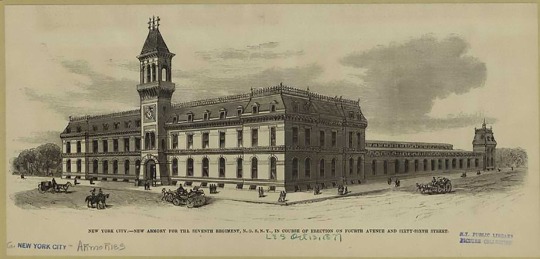
The New York Public Library
5. Harbor
New York Harbor was deep enough that it didn’t freeze over, so it could actually operate year-round. Lots of raw products — grains, sugars from the Caribbean — can all be exchanged in this deep-water port and then processed and sent by way of the Erie Canal into the heartland, and also traded across the Atlantic. So New York becomes kind of a central economic exchange hub, feeding and processing so much of what is being consumed by the growing middle classes of North America, and Europe.

Currier & Ives/Library of Congress
6. Orchard Street
As the wealthy Protestant elite move uptown, away from the waterfront, the lower east side becomes a neighborhood of immigrants. Jewish and Italian immigration really starts in great numbers in the latter part of the 19th century. Millions of people are coming to New York. They’re dazzled by visions of streets of gold.
The older tenements on the lower east side become jam-packed. The whole notion of a middle class apartment with one person in a room — that didn’t exist. A single apartment could house multiple extended family members; a family might even rent out a room to make ends meet. The idea of how you used space was different. The streets were really an extension of where you lived.
Take the market on Orchard Street. It was really an American reproduction of the small market towns that many Jews had left in eastern Europe. If you look at old photos, you can just imagine the sounds and smells. Jews, Italians, and Chinese are living side by side. And out of that, a port culture begins to emerge. People are bringing the cultures that they left. Lots of languages are being spoken, and lots of new dishes and new fashions are being created. It’s all part of this new, intermingled culture. And that intermingling, I think, is what’s distinctive to New York City — as opposed to the culture of the uptown elites, who are really emulating their fantasy of the european aristocracy.
The uptown elites, by the way, are really scared of this new, intermingled port culture. They have a certain notion of Protestant destiny in terms of who this country properly belongs to. They’re concerned with who’s creating value — monetary, but also the cultural value of the nation. Meanwhile, these non-Protestants of suspect racial origin keep coming into the city. So there’s a growing guardedness of who should count, who belongs there.
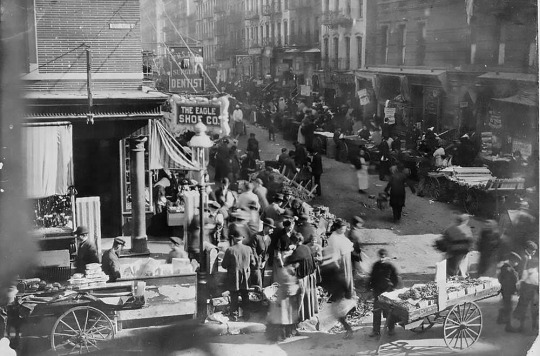
Bain News Service/Library of Congress
7. Bowery
While the elites are walking up and down Broadway, checking each other out in a way that prefigures the shopping mall or the arcade, immigrants and members of the white working class hang out on the Bowery. It’s where people go for dime museums, tattoo parlors, bars; all that kind of popular culture that we tend to think of now as connected to Coney Island originates on the Bowery.
These new immigrant and working class audiences are constantly looking for new and exciting forms of expression. They’re willing to pay maybe five cents to see what’s happening on the stage, what’s happening in music, and in bars. Essentially, what happens is street culture gets brought into the commercial culture, the indoor culture in which people are willing to pay for entertainment.
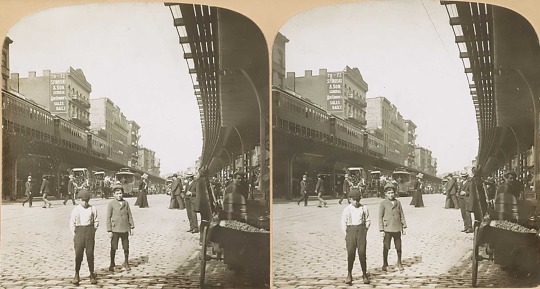
Library of Congress
#The Gilded Age | Article#American Experience#NOVA | PBS#New York | Gilded Age#Jack Tchen | Associate Professor | NYU’s Gallatin School of Individualized Study
5 notes
·
View notes
Text

Walls / Vanderbilt Avenue, New York City, New York.
16 notes
·
View notes
Text
Summit One Vanderbilt, New York: Above floor 73, the top of One Vanderbilt contains an observation deck called Summit One Vanderbilt. Summit One Vanderbilt spans 71,938 square feet and contains some restaurants. There is a bar on the top floor where you can enjoy a cocktail and watch New York from the best advantage point... One Vanderbilt is a 73-story supertall skyscraper at the corner of 42nd Street and Vanderbilt Avenue in the Midtown Manhattan neighborhood of New York City. Wikipedia
90 notes
·
View notes